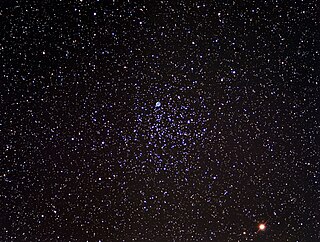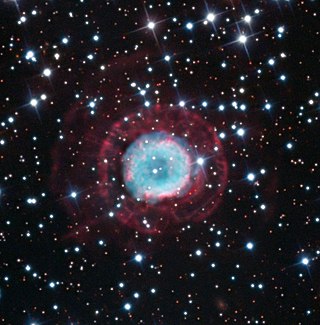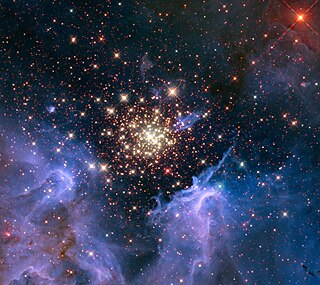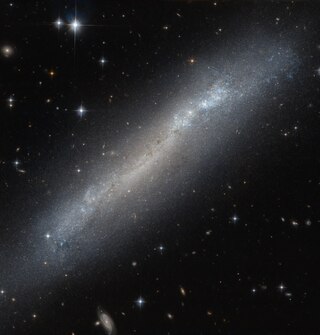
The New General Catalogue of Nebulae and Clusters of Stars is an astronomical catalogue of deep-sky objects compiled by John Louis Emil Dreyer in 1888. The NGC contains 7,840 objects, including galaxies, star clusters and emission nebulae. Dreyer published two supplements to the NGC in 1895 and 1908, known as the Index Catalogues, describing a further 5,386 astronomical objects. Thousands of these objects are best known by their NGC or IC numbers, which remain in widespread use.

Messier 46 or M46, also known as NGC 2437, is an open cluster of stars in the slightly southern constellation of Puppis. It was discovered by Charles Messier in 1771. Dreyer described it as "very bright, very rich, very large." It is about 5,000 light-years away. There are an estimated 500 stars in the cluster with a combined mass of 453 M☉, and it is thought to be a mid-range estimate of 251.2 million years old.

The Little Dumbbell Nebula, also known as Messier 76, NGC 650/651, the Barbell Nebula, or the Cork Nebula, is a planetary nebula in northern constellation Perseus. It was discovered by Pierre Méchain in 1780 and included in Charles Messier's catalog of comet-like objects as number 76. It was first recognised as a planetary nebula in 1918 by the astronomer Heber Doust Curtis. However, there is some contention to this claim, as Isaac Roberts in 1891 did suggest that M76 might be similar to the Ring Nebula (M57), being instead as seen from the side view. The structure is now classed as a bipolar planetary nebula (BPNe), denoting two stars which have burst, leaving neutron star or white dwarf remnants and luminous envelopes. Distance to M76 is currently estimated as 780 parsecs or 2,500 light years, making the average dimensions about 0.378 pc. across.

NGC 2438 is a planetary nebula in the southern constellation of Puppis. Parallax measurements by Gaia put the central star at a distance of roughly 1,370 light years. It was discovered by William Herschel on March 19, 1786. NGC 2438 appears to lie within the cluster M46, but it is most likely unrelated since it does not share the cluster's radial velocity. The case is yet another example of a superposed pair, joining the famed case of NGC 2818.

NGC 1559 is a barred spiral galaxy in the constellation Reticulum. It is also a Seyfert galaxy. Although it was originally thought to be a member of the Dorado Group, subsequent observations have shown that it is in fact not a member of any galaxy group or cluster and does not have any nearby companions. NGC 1559 has massive spiral arms and strong star formation. It contains a small bar which is oriented nearly east-west and spans 40″. Its bar and disc are the source of very strong radio emissions.

NGC 1316 is a lenticular galaxy about 60 million light-years away in the constellation Fornax. It is a radio galaxy and at 1400 MHz is the fourth-brightest radio source in the sky.

Sher 25 is a blue supergiant star in the constellation Carina, located approximately 25,000 light years from the Sun in the H II region NGC 3603 of the Milky Way. It is a spectral type B1Iab star with an apparent magnitude of 12.2. Its initial main sequence mass is calculated at 60 times the mass of the Sun, but a star of this type will have already lost a substantial fraction of that mass. It is unclear whether Sher 25 has been through a red supergiant phase or has just evolved from the main sequence, so the current mass is very uncertain.

A dwarf spiral galaxy is the dwarf version of a spiral galaxy. Dwarf galaxies are characterized as having low luminosities, small diameters, low surface brightnesses, and low hydrogen masses. The galaxies may be considered a subclass of low-surface-brightness galaxies.

NGC 1672 is a barred spiral galaxy located in the constellation Dorado. It was discovered by the astronomer James Dunlop on November 5, 1826. It was originally unclear whether it was a member of the Dorado Group, with some sources finding it to be a member and other sources rejecting its membership. However, recent tip of the red-giant branch (TRGB) measurements indicate that NGC 1672 is located at the same distance as other members, suggesting it is indeed a member of the Dorado Group.

NGC 1058 is a Seyfert Type 2 galaxy in the NGC 1023 Group, located in the Perseus constellation. It is approximately 27.4 million light years from Earth and has an apparent magnitude of 11.82. It is receding from Earth at 518 kilometers per second (322 mi/s), and at 629 kilometers per second (391 mi/s) relative to the Milky Way.

NGC 6250 is a young open cluster of stars in the southern constellation of Ara.

NGC 5544 is a barred spiral galaxy in the constellation Boötes. It is interacting with spiral galaxy NGC 5545.

NGC 6144 is a globular cluster in the constellation Scorpius, located almost exactly 1° away from its brighter counterpart globular cluster Messier 4. It is relatively close to and is partially obscured by the Rho Ophiuchi cloud complex. The cluster has a very low core stellar density for a globular cluster and harbors a handful of X-ray radiation sources.

NGC 1433 is a barred spiral galaxy with a double ring structure located in the constellation of Horologium. It is at a distance of 46 million light-years from Earth. It is a Seyfert galaxy with an active galactic nucleus. The central region of the galaxy displays intense star formation activity, with an irregular star-forming ring of 5″ radius and weak radio wave emission. Star formation is also noticeable in the spiral arms but not the bar of the galaxy. NGC 1433 is being studied as part of a survey of 50 nearby galaxies known as the Legacy ExtraGalactic UV Survey (LEGUS). A jet of material flowing away from the central black hole of the galaxy extending for only 150 light-years has been found. It is the smallest molecular outflow ever observed in a galaxy beyond our own.

NGC 4478 is an elliptical galaxy located about 50 million light-years away in the constellation Virgo. NGC 4478 was discovered by astronomer William Herschel on April 12, 1784. NGC 4478 is a member of the Virgo Cluster.

NGC 2336 is a Barred spiral galaxy located in the constellation Camelopardalis. It is located at a distance of circa 100 million light years from Earth, which, given its apparent dimensions, means that NGC 2336 is about 200,000 light years across. It was discovered by Wilhelm Tempel in 1876.

NGC 3367 is a barred spiral galaxy located in the constellation Leo. It is located at a distance of about 120 million light years from Earth, which, given its apparent dimensions, means that NGC 3367 is about 85,000 light years across. It was discovered by William Herschel on March 19, 1784.

NGC 4636 is an elliptical galaxy located in the constellation Virgo. It is a member of the NGC 4753 Group of galaxies, which is a member of the Virgo II Groups, a series of galaxies and galaxy clusters strung out from the southern edge of the Virgo Supercluster. It is located at a distance of about 55 million light years from Earth, which, given its apparent dimensions, means that NGC 4636 is about 105,000 light years across.

NGC 5846 is an elliptical galaxy located in the constellation Virgo. It is located at a distance of circa 90 million light years from Earth, which, given its apparent dimensions, means that NGC 5846 is about 110,000 light years across. It was discovered by William Herschel on February 24, 1786. It lies near 110 Virginis and is part of the Herschel 400 Catalogue. It is a member of the NGC 5846 Group of galaxies, itself one of the Virgo III Groups strung out to the east of the Virgo Supercluster of galaxies.

NGC 2188 is a barred spiral galaxy in the constellation Columba. It is located at a distance of circa 25 million light years from Earth, which means that the galaxy, given its apparent dimensions is about 50.000 light years long. It was discovered by John Herschel on January 9, 1836.




















